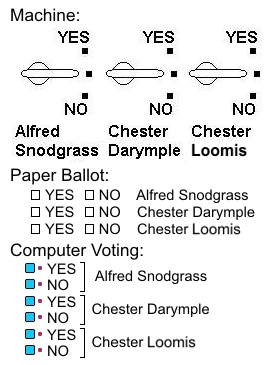The widespread use Plurality Voting System (PVS) is the reason we have unfair
elections.

Plurality
Blend-O-Vote
- The Plurality Voting System unfairly favors the candidate most different from the
others.
- The Plurality Voting System unfairly disfavors the candidate most similar to the
others.
- The voter who likes more than one candidate unfairly can't choose more than one.
- The voter's vote doesn't count when the voter doesn't like any of the candidates.
- With PVS, it's impossible for a majority to vote to stop an unwanted candidate.
- The Plurality Voting System selects the candidate most different from the others in
the primary elections.
- The two candidates most different from the others picked by the primaries face off
in the general elections.
- Third party candidates then mess with the general election to select the worst
candidate possible to win the election.
The Plurality Voting System fits Granholm's definition of the kludge perfectly:
- An ill assorted collection of poorly matching parts, forming a
distressing whole.
- Granholm then cited the camel as the perfect example of the kludge.
How can we get rid of this unfair bias?
- There is only one way:
- Make YES and NO votes have the same weight.
There is only one way to make this happen:
- Two things must be done:
- The Plurality Voting System (vote for only one) used in most places must be
permanently abolished.
- The Independent Voting System (vote on each choice
separately) must be adopted into law.

Independent Voting
- The voter has 3 choices for each candidate: YES, NO, and ABSTAIN.
- The default if the voter does nothing is always ABSTAIN.
- On a lever machine, a three position control is used for each candidate (at right).
- Each paper ballot candidate has YES and NO check boxes.
- Checking neither or both check boxes is ABSTAIN.
- Computer ballots, like paper ballots, would have YES and NO buttons for each
candidate.
- There is no interlocking of votes between candidates.
- Each candidate's score is his YES votes minus his NO votes.
- The candidate with the highest positive score wins.
With the Plurality Voting System, a vote with no YES vote for an office is not
counted at all.
With the Independent Voting System, all votes except ABSTAIN votes are counted equally:
- The Independent Voting System does not unfairly favor any candidates.
- The voter who likes more than one candidate is not disenfranchised.
- The voter who doesn't like any of the candidates is not disenfranchised.
- The Independent Voting System selects the candidate who pleases the most people.
- The Independent Voting System lets a majority vote to stop an undesirable candidate.
- Third party candidates don't mess up the general election.
Thus, the Independent Voting System selects the candidate who pleases the most people,
not the candidate most different from the others.


